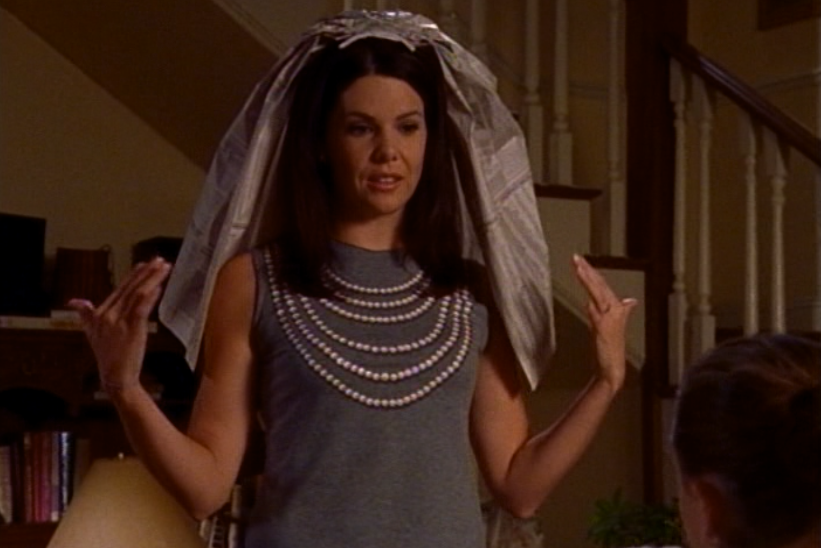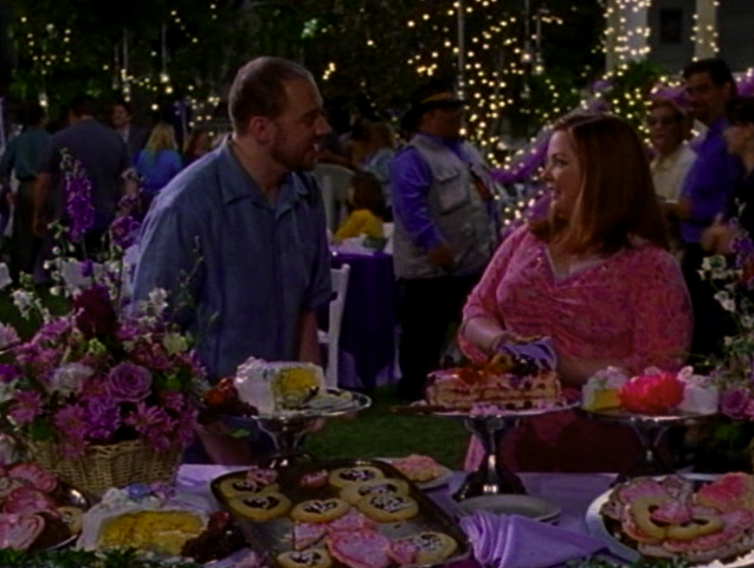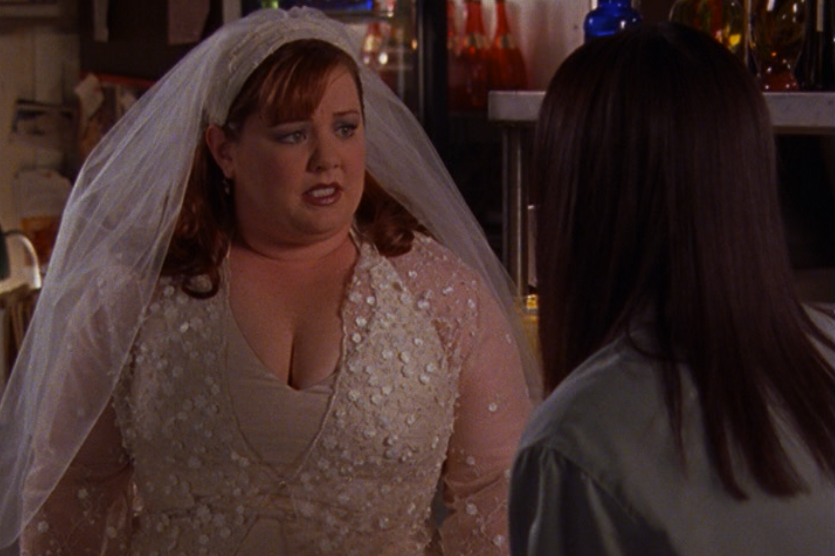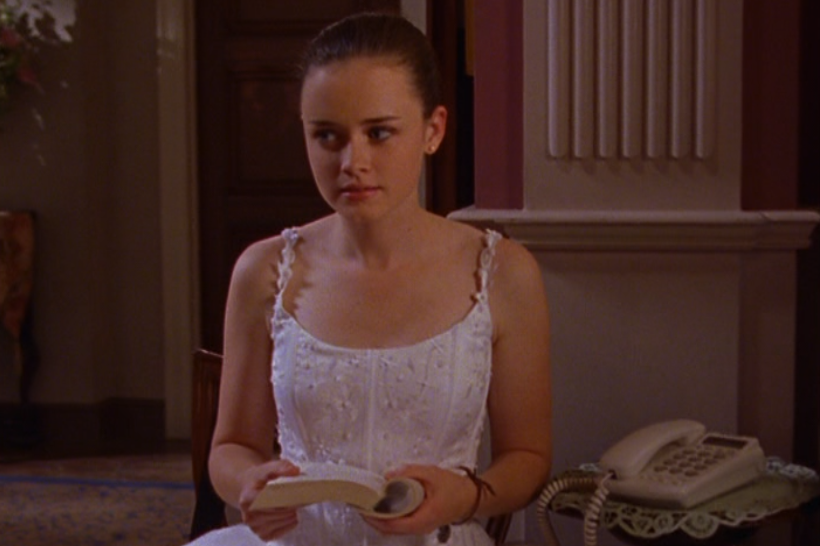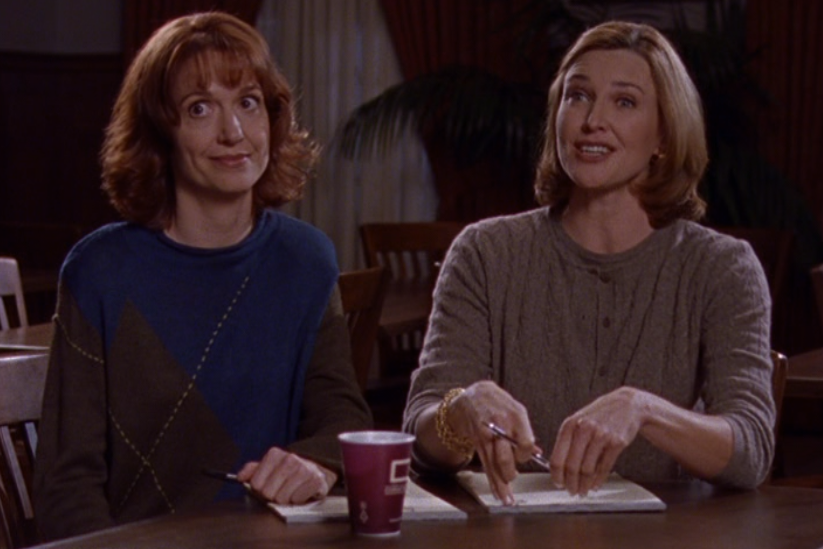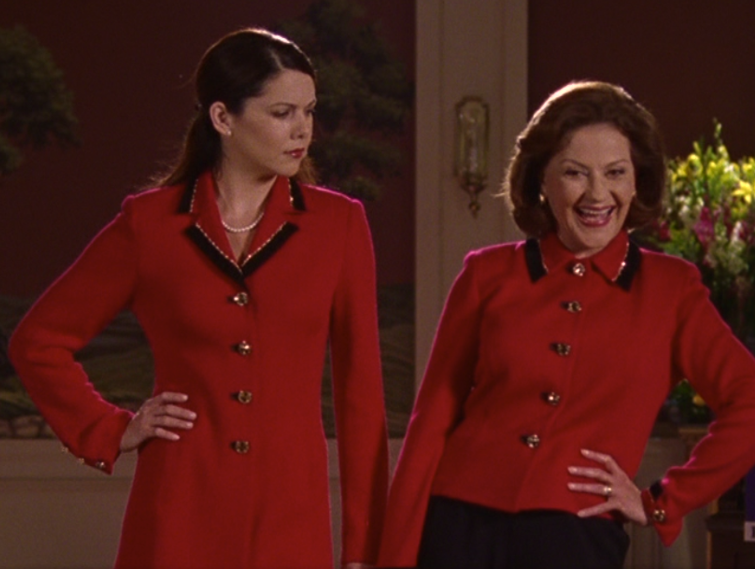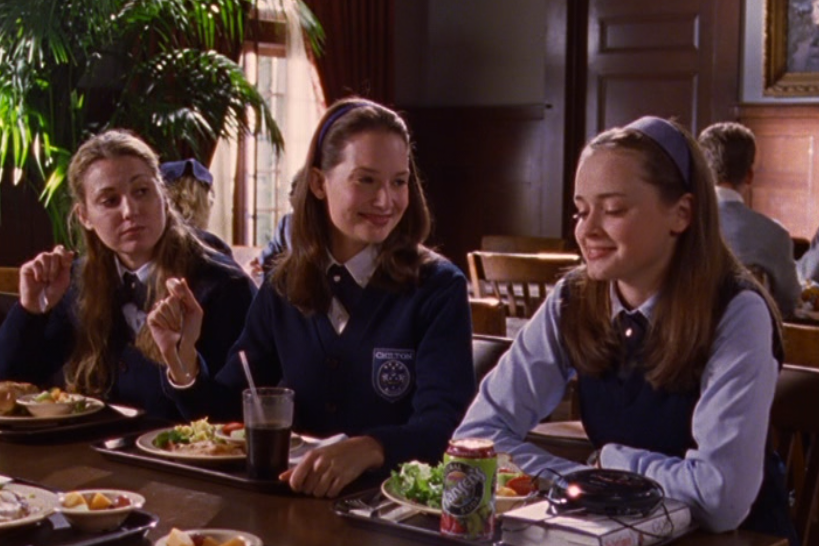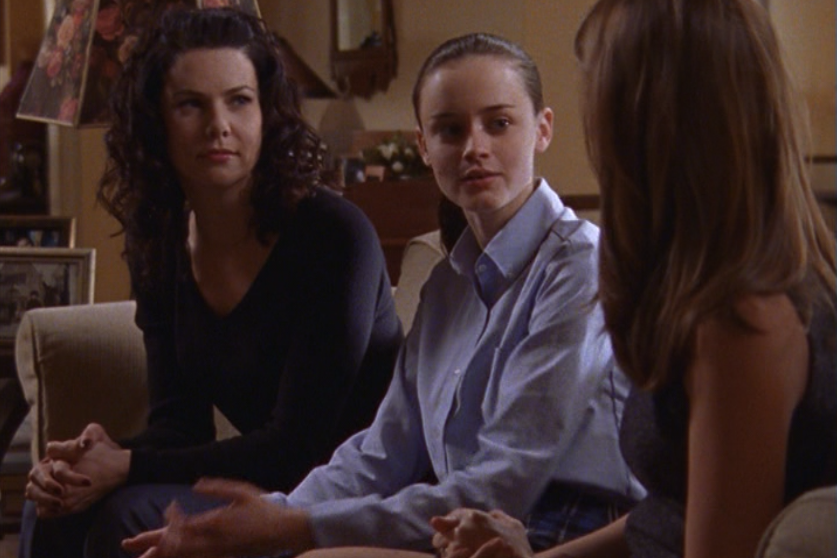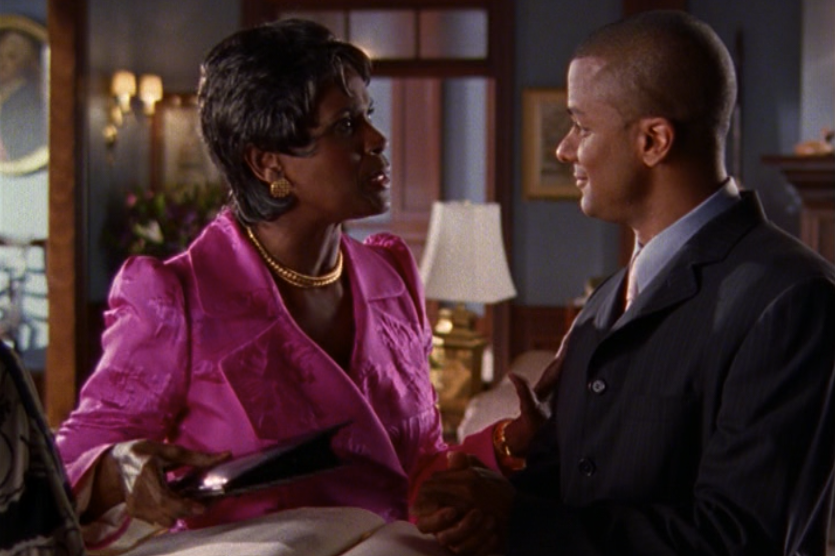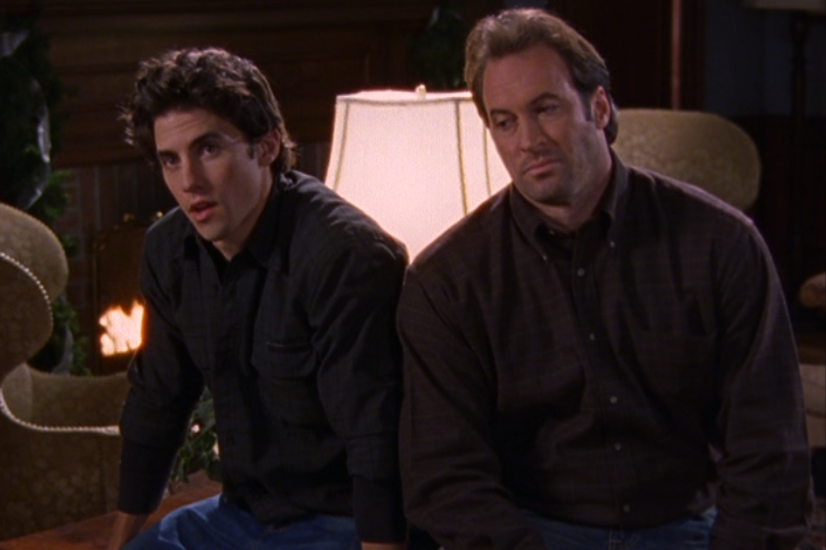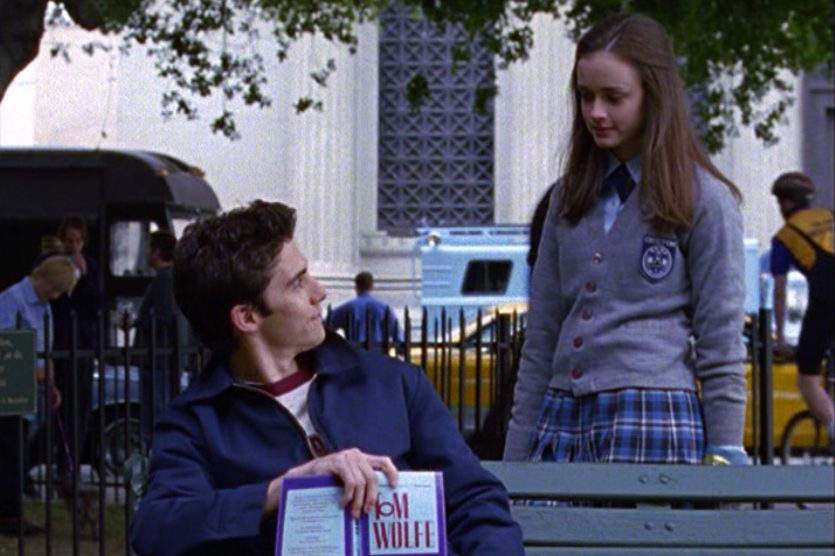“It Should’ve Been You”
Costume Design on Season Two of Gilmore Girls
Originally published on Letterdrop 7/28/2022
When season two opens, Lorelai has a thousand yellow daisies and a big question: Will she marry Max?
The answer is, well, yes and no.
Lorelai in 2.1
Yes, she accepts Max’s proposal, and he buys her an art deco engagement ring (2.1): “supposedly ripped right off of Zelda Fitzgerald’s cold, dead hand,” says Lorelai (dark!). And yet, when she first tries on the ring, it doesn’t fit. Frankly, neither will Max and Lorelai.
(Note the yellow flowers trimming Lorelai’s slip dress—they’ll bloom again in a couple episodes, the bookends to Max and Lorelai’s engagement.)
Lorelai in 2.2
Indeed, much of their engagement is marked by metaphors of bad fit, of trying things on and knowing they’re not quite right. In episode two, Lorelai uses newspaper to experiment with veil lengths, torn between something “shoulder length” and something “longer.” When Rory suggests a bridal shop, Lorelai cringes: Taffeta gives her “cotillion flashbacks.” Cotillion, of course, was the last time Lorelai was almost forced into a white dress—not by an ill-advised marriage but by her mother, Emily.
Lorelai struggles to tell Emily about the engagement. When she finally does, Emily is cold. Lorelai accuses her mother of not caring, of “never caring,” only to find that she does, deeply: Emily has known about the engagement for weeks and is heartbroken that Lorelai told everyone but her.
Who else loves this stained glass window (2.2)?
And so the veil—that symbol of cotillion—becomes almost a peace offering between mother and daughter. Lorelai brings two options, this time in tulle—one shoulder length and one longer—to the Gilmore mansion. When Emily refuses to choose one, Lorelai apologizes for not telling her about the engagement: “I’m just afraid you’re going to make me feel bad about [good things in my life]. . . . You think your words don’t have any effect on me, but they do.”
Emily listens quietly, only to blurt out, as Lorelai leaves, “Your head is much too big for a veil.” At first, Emily seems to be doing what Emily usually does: offer unconstructive criticism. (In 1.19, we learned Emily often told little Lorelai that she had an “unusually large head.”)
But then, Emily pauses and clarifies: “You might consider a tiara.”
She meets Lorelai’s gaze: “That’s what I wore.”
Lorelai and Emily in 2.2
Both women are moved by this exchange, their eyes wet with tears. Instead of leaving Lorelai adrift in her criticism, Emily acknowledged their similarities, their shared “flaws” (the implication being that Emily also thought her head was “too big” for a veil). Instead of pushing Emily away, Lorelai brought her into a decision and considered her advice.
Look back at the top Lorelai wore with her newspaper veil—the strands of pearls. And now look at Emily, in her pearl necklace and pink polo, and Lorelai, in her light blue polo. Lorelai and Emily rarely dress at the same level of formality and certainly not in the same pieces; in this scene, they are closer to understanding each other than they’ve ever been.
Emily in 2.3
Ultimately, Lorelai’s engagement means more for Emily and Lorelai’s relationship than Max and Lorelai’s. In episode three, Emily attends Lorelai’s bachelorette party—looking a little overdressed in a black blazer with silver embroidery. Lorelai, too, is in black, a counterintuitive choice for a bride-to-be: black pants and a black long-sleeve top patterned with—that’s right—yellow daisies.
It’s always a bad idea to call Christopher (2.3)!
Over drinks, Emily recounts how she felt in the days before marrying Richard: all butterflies and anticipation. “For the entire week before my wedding, I’d wait ’til my mother went to sleep, and I’d sneak out of bed, and I’d put on my wedding dress and my tiara and my gloves, and I’d stare at myself in the mirror and think how very safe I felt, how very right and wise and honored.” The other attendees are moved to call their significant others, but Lorelai calls Rory’s father, Christopher—her comfort person. It’s the beginning of the end for Max, the wilt on the yellow daisies. When Lorelai decides to run away right before the wedding, Rory asks why.
God help us, they won’t get together for two more years (2.3).
“Because I didn’t want to try on my wedding dress every night,” Lorelai replies. Her tank top says as much: danger in traffic-light red. Lorelai finally understands what the rings and veils and dresses have been saying all along: This is not the right fit. And Emily, inadvertently, got her there.
Jackson and Sookie at the dessert table (2.2)
We still get a wedding in season two: Sookie and Jackson’s. The show hints at their eventual engagement in episode 2.2: At Lorelai and Max’s shower, Jackson and Sookie discuss marriage in front of the dessert table—like the decorations, the cakes and cookies are all shades of pink and purple.
Sign you shouldn’t get married #1: You’d rather visit the local diner owner while he refills ketchup bottles than spend another minute at your own shower.
In a romantic pink floral dress, Sookie looks more like the honoree than Lorelai, in blue and bronze.
Sookie in 2.22
(A shout-out to Sookie’s gorgeous wedding dress, above. The costume department doesn’t always do right by Sookie—especially, as I’ll discuss in future issues, in later seasons—but she looks stunning here.)
There is no occasion Rory won’t bring a book to, and I love her for it (2.6).
The other woman in white this season? That’s Rory. In episode six, she accidentally interrupts Emily’s tea with a few DAR friends. Emily has been missing her society events lately, thanks to a moody Richard, and in Rory, she sees the opportunity to triumphantly reenter society with the “prettiest” debutante—finally, someone to wear Lorelai’s “old dress.” Unlike Lorelai, who fiercely rejected debutante balls and their taffeta trappings, Rory doesn’t mind debuting: She knows it’s “really important” to Emily and “not that important” to her.
Miss Manners says to always match your tea service to your outfit (2.6).
And your friends’ (2.6).
With Rory’s debut comes our first glimpse at Emily’s circle and her role within it. Her friends look much as you’d expect—pearls, silk blouses, immovable hair—with one exception: a cheeky British blonde in gold dangly earrings and a black-and-white-printed jacket with furry cuffs. Surprisingly, Emily’s color palette is most closely aligned with this friend’s: her jacket black-and-white, her jewelry gold. Among her friends, Emily is as daring as a British expat among the Daughters of the American Revolution. When Emily makes a joke about “sacrificing a virgin,” one of her pearl-clad friends laughs and exclaims: “The things you say!”
Emily is, I would argue, the Lorelai of her society set.
After all, only an episode later, we see Lorelai fitting in with the same women Emily would call peers. Both Lorelai and Rory have been shamed into a Chilton social life—Lorelai in the Chilton Booster Club, and Rory, inadvertently, in a secret sorority, the Puffs.
Boosters 1 and 2 (2.7)
Booster 3 and Aubrey (2.7)
The Boosters are closer in generation and style to Emily than Lorelai: sweater sets, plaid blazers, gold hoops. In fact, the closest person in age and dress to Lorelai is Aubrey, a new stepmother: her black leather blazer like one Lorelai often wears.
Why, Lorelai?
(Lorelai, unfortunately, has not foregone her offensive T-shirts this season.)
Note the Emily-like pearls on Lorelai
Lorelai offers the perfect location for the Boosters’ fashion show fundraiser—the Independence Inn—then coerces Emily into modeling alongside the Boosters. Emily worries her runway look will be “tasteless or zebra striped or spandex,” but Lorelai should be more concerned: They’re the “mother-daughter team,” coordinated in Emily-approved red suiting. As Rory teases later, they “look like Nancy Reagan.”
Still, Lorelai loosens up on the runway with an exuberant Emily, even jokes with the Booster women afterward. Emily looks on approvingly: “How nicely you seem to be fitting into the world you ran away from,” she remarks—both still in their matching suiting.
Rory sits with the Puffs (2.7).
Rory, too, fits more easily into the Chilton scene than she expected: She accidentally sits at the lunch table of the school’s most powerful sorority, then gets invited back. She’s wearing her usual navy sweater-vest, almost all the Puffs in navy cardigans. Rory’s not quite a Puff, but she’s soft enough to fit in with them.
Paris lurks behind the Puffs’ table (2.7)
Only Paris, desperate to be “Puffed” like her mother before her, is clad in a blue blazer. She’s “way too intense,” declare the Puffs—Paris’s blazer marking her as too severe, too “masculine,” for this mini matriarchy.
Rory and her lunch companion in 2.7
Though Rory happily returns to her usual table, she’s joined by another almost-Puff who prefers to read and listen to music at lunch. No surprise, they’re both in sweater-vests.
The other team never stood a chance (2.14).
Indeed, this season provides many fashion doppelgängers for our Gilmore girls. In episode fourteen, Christopher and his new girlfriend, Sherry Tinsdale, attend Rory’s debate. (Note Paris and Rory in matching blue blazers, united against an ill-prepared team in discordant uniforms.)
Rory and Sherry in 2.14
Lorelai and Sookie observe Sherry from afar, remarking on her wrinkle-free dress, her lack of pantyhose. Through their eyes, Sherry appears effortlessly presentable and fashionable: “a chic, good hair, wrinkle-free, no-hose-wearing witch,” snarks Lorelai. In reality, Sherry is just as intimidated by Lorelai as Lorelai is by her: She wants to get to know Rory but asks for Lorelai’s approval to do so.
Lorelai and Rory in 2.14
Thus, Lorelai becomes a reluctant bridge between her daughter and Sherry: her black sweater picking up the black leather stripe on Sherry’s sleek sheath, her gray-blue slacks somewhere between Rory’s blue and Sherry’s gray.
Sherry even wears diamond studs, just like the set Lorelai kept from her teenage years. To Emily, to even Lorelai, Sherry is the ghost of a past that never could’ve been: “Christopher [got] his life together with that woman,” Emily tells Lorelai. “It should’ve been you!”
Emily’s red suiting, so joyous in the previous episode, takes on a somber tone when she visits Mia (2.8).
Emily, too, encounters a doppelgänger this season. The Independence Inn’s owner, Mia, visits in episode eight, much to Lorelai and Rory’s delight. She is their surrogate mother and grandmother, the provider of Lorelai’s first job and home away from the Gilmore mansion. When Emily discovers Mia is in town, she decides to visit her.
Mia’s style is simple and approachable, like Mia herself; she doesn’t adorn herself in the way Emily does, with gold buttons and trim. And yet, when the two women stand next to each other, they share DNA: Emily’s black floral brooch—never to be seen again—echoes Mia’s round brooch and black clothing; Mia’s little gold hoops mirror Emily’s larger ones. For at their hearts, they want to care for Lorelai but in different ways: Mia took in Lorelai because she hoped someone would do the same for her daughter; Emily hoped someone would send Lorelai home.
Michel’s orange-and-pink striped tie picks up the colors in his mother’s outfit (2.18).
Another visitor arrives in episode eighteen: this time, Michel’s mother, Gisele. Mother and son seem as in harmony as their rhyming names: They love to gossip, shop, and eat pasta together; when they tease each other, their comments are all toothless fun. Lorelai cannot comprehend such a lighthearted parent-child relationship. She’s never had anything like it with Emily or even Rory.
Then Lorelai mentions Michel’s restrictive eating to Gisele, and suddenly, the relationship collapses. Turns out, it was built on air: “I tell her nothing,” explains Michel. “We keep all subjects light and fluffy. We talk about clothes and food and Posh Spice and David Beckham, and that is all. . . . Now she knows I’ve been hiding something from her. Suddenly she’s asking questions: Why did I leave France at eighteen?”
Michel is more like Lorelai than either realized: He even left home as a teenager. He’s just better at compartmentalizing with Gisele than Lorelai is with Emily—and he has the distance (all the way to France!) to do so.
But the next day: clashing colors (2.18)
Gisele’s wardrobe should’ve been a tip-off: Her floral coat and dress set may be a little more fashionable and youthful than Emily’s clothes, but her gold studs and chain necklace are dead ringers for the Gilmore matriarch’s favorite jewelry. When Gisele learns about Michel’s dieting, she looks even more like Emily, in a bright pink skirt suit. Lorelai has, to quote Michel, “turned [Gisele] into a mother”—specifically, her mother.
(An aside: Gilmore Women reads Lorelai’s reveal as “a metaphor for outing,” albeit a “really weak” one, and I’m inclined to agree. The show frequently codes Michel as queer—his obsession with thinness, his love for Celine Dion—but doesn’t confirm said queerness until the revival. I only wish the show had fully explored his sexuality—and, perhaps, how it played into his early departure from home.)
Lane in her home outfit (2.13)
Lane in her date outfit (2.13)
Lane is also living two lives: one for her and one for her mother. But this season, those lives start to weave into each other: She’s dating Rory’s classmate Henry, a boy “[her] parents would approve of” (1.17). Used to hiding the things she loves from her mother, Lane insists on hiding Henry, too: calling him through Rory, planning a decoy date to obscure their real one.
But in episode thirteen, Henry grows tired of the subterfuge, and in a way, so does Lane. After Henry breaks it off, Lane heads home, still wearing her date outfit: a rhinestone-embellished T-shirt, not a Mrs. Kim–approved sweater and button-down, under her denim jacket. She’s so heartbroken that she doesn’t even think to change before her mother sees her.
Hang in there, Lane—some good stories are on your horizon.
Richard even wears a “work jacket” in retirement (2.12).
Season two also brings a rarer father-daughter story, through Lorelai and Richard’s work lives: After a brief retirement, Richard returns to the insurance business, this time starting a one-man firm. He’s lost without his longtime secretary, Margie, and Lorelai offers to help him get settled and hire a replacement (2.20). They bond over office-supply shopping and desk lunches, and Richard sees Lorelai’s business savvy in action.
Richard’s eventual secretary, Karen, loves a work jacket (2.20).
He quickly becomes reliant on his daughter, as he was on Margie—until Lorelai reminds him that she, too, has a full-time job. You’d think Richard would remember: Only a few months earlier, he visited the inn and asked Lorelai where her “work jacket” was. And yet, he says nothing about the jacket-less outfits she wears around his office. Indeed, Lorelai and her wardrobe seem to suit Richard just fine in their firm of two—where there are no outer forces to judge or appease.
Lorelai at the launch (2.20)
This poor woman is going to have the life force beaten out of her by the Gilmores, isn’t she?
Only once Lorelai leaves is Richard convinced to hire a new secretary: Karen, Lorelai’s pick for the position. At the firm’s launch, both Karen and Lorelai wear lace—Karen in a cardigan and dress, and Lorelai in a jacket-less sheath. As Richard says, “[Karen is] . . . no Margie”—but the pause in his sentence says she’s really no Lorelai.
A boy in hell (2.5)
And, of course, I can’t end this issue without discussing the new boy in Stars Hollow, Jess Mariano—and his uncle and surrogate father, Luke.
In episode five, Jess slouches off the bus from New York. His mother, Liz, wants Luke to “straighten him out,” and Luke, forever the fixer of his little sister’s problems, agrees to try. Jess is immediately disenchanted with his new home: “This Is Hell” plays as he surveys the quaint townspeople (including a mother and daughter in matching pink dresses and twin toddlers in matching overalls). In his puffy blue vest, camouflage long-sleeve, jeans, and cuff watch, Jess looks completely out of his element.
Jess wears a Punk Planet T in 2.15; in season four, he’ll read an issue.
Let’s break down Jess’s style: He loves metal and punk, so there are the requisite band T-shirts, their graphics often unappetizing, layered over long-sleeves. He wants to come off as tough, so there are militaristic touches: cargo jackets and button-downs with iron-on patches and his often-repeated camo shirt (maybe, too, he wants to disappear a little).
Still, not all of Jess’s clothes hold people at a distance. That puffy vest from his first scene? Luke has one in olive; it first appeared in 1.7. Certainly Jess and Luke are a lot alike, much as either one would deny it, and while Luke struggles to parent Jess, he is probably the most consistent adult presence Jess has had in his life. (The show references, somewhat offhandedly, Liz’s struggles with terrible boyfriends and sobriety, including while she was pregnant with Jess.)
Bracebridge bros (2.10)!
Look at Jess and Luke at the Bracebridge Dinner in episode ten: dressed nearly identically in their dark button-downs and jeans. Together, they sit apart from the other guests, snarking over the festivities.
Luke and Jess at the bridge (2.19)
And again, look at them in episode nineteen, in complementary olive jackets. Despite his voracious reading, Jess is behind in school, and Rory agrees to tutor him one evening. The night ends when they drive to get ice cream and Jess accidentally crashes Rory’s car. Luke looks for Jess and finds him in the one spot he seems to like in Stars Hollow.
“I made sure [Rory] was okay,” says Jess.
“I know you did,” Luke replies—understanding, I think, that beneath Jess’s hard outer shell, beneath that tough jacket, he cares deeply. The other townspeople may see Jess as a loner, a delinquent, but Luke sees himself.
Luke in his vest (2.20)
Luke’s olive vest reappears in the next episode, when Rory tells him the accident wasn’t Jess’s fault. “I know it wasn’t,” Luke replies—echoing his words from 2.19 and affirming their shared belief in Jess’s decency.
Jess picks up the bracelet (2.13).
Rory has been dating Dean all season and denying her growing feelings for Jess. She doesn’t notice when she loses the bracelet Dean gave her (2.13)—though Dean certainly does (2.15). The bracelet symbolizes Dean’s possessiveness—a way that he marks Rory as “his”—and Rory’s changing heart.
Rory finds Jess on a Washington Square Park bench (2.21).
After Jess is sent back to New York, Rory skips class to visit him (2.21). She’s still wearing her Chilton uniform—but her cardigan is gray instead of her usual blue.
Jess in gray (2.16)
A couple reasons for this: One, blue is definitively Lorelai’s color—and Lorelai doesn’t approve of Jess or Rory skipping class for him. Gray is much more Jess’s color (see, for example, the above look in 2.16).
And two, the character most associated with this gray cardigan is Madeline, Rory’s classmate and sometimes friend. The last time Rory was in New York, she attended a Bangles concert with Paris, Madeline, and Louise; the latter two left midway with a couple of strange boys (1.13). This is how alien Rory’s behavior is to herself: She’s dressed more like Madeline, like a girl, she thinks, who would make a spontaneous, somewhat reckless decision for a boy—a boy, Rory must now admit, that she likes.
Rory and Lorelai in 2.22
Jess returns to Stars Hollow in the season finale, and Rory kisses him just before Sookie’s wedding ceremony. Lorelai is in the midst of a different love triangle: She sleeps with Christopher just before he learns Sherry is pregnant.
Like mother, like daughter indeed: They walk down the aisle in their teal bridesmaid dresses, the color between Lorelai’s signature blue and Rory’s signature green. They’re almost a mirror to that matching mother and daughter Jess saw on his first day in Stars Hollow: the messy reality behind a picturesque scene.
Favorite Line from Season Two
Every issue, I’m providing my favorite line(s) from that season. This one comes from episode 2.3, and I recommend employing it whenever you’re under the weather.
Michel: (hungover) I feel like crap on toast.
If you enjoyed this post, please like, comment, or share! I have another project on my plate this summer, so I’m moving these posts from every two to every three weeks. Season three will arrive on Thursday, 8/18.
Essential Episodes for Season Three
3.5: “Eight O’Clock at the Oasis”
3.10: “That’ll Do, Pig”
3.13: “Dear Richard and Emily”
3.15: “Face-Off”
3.21: “Here Comes the Son”

